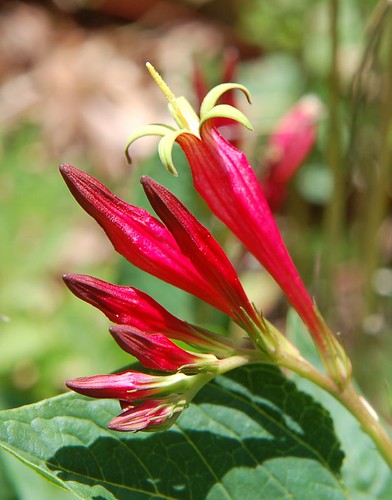
In the July 15th post, TheGardenLady wrote about her visit to Chanticleer. One of the pleasures of touring a garden is to discover “new” plants. TheGardenLady and her friends found a plant that they had never seen before.
Chanticleer has, at each of their gardens, a list of all the plants that are located in that garden and on their website they have a list of all the plants in the gardens. But long lists are difficult to use.
However, one page of the Chanticleer website has a special listing of what is blooming by date and TheGardenLady was able to locate the plant on the date when it was first blooming in the park at an area called The Water Wheel.
The plant is called Spigelia marilandica. Spigelia marilandica has upward facing, trumpet-shaped, brilliant red flowers (to 2″ long) atop stiff stems growing to 18″ tall. Each flower is yellow inside and flares at the top to form five pointed lobes which looks like a yellow star. Flowers bloom in June. It has glossy green, ovate to lance-shaped leaves that are up to 4″ long.  It is described as one of the most striking and beautiful of the native perennials. This is exactly how TheGardenLady and her friends felt when seeing the plant for the first time, even before they knew what it was.
Apparently this plant is a native plant of Southeastern US but websites say that it will survive as far north as Zone 5. There are common names for this plant such as Indian Pink or pinkroot. It likes a bright woodland in shade or partial shade or sun plus well drained soil. A surprisingly hardly plant, though it is best established by late summer for reliable success in gardens and containers. It has no known diseases or pest problems and Deer don’t
like it.
It should never be taken from the wild. It can be bought in numerous
nurseries. TheGardenLady was able to buy Spigelia marilandica at Russell Gardens Wholesale, but they said the plant is very popular so they had few left. There are other places where one can buy Spigelia marilandica (e.g. here or here).
Let TheGardenLady know what you think of this native plant.





